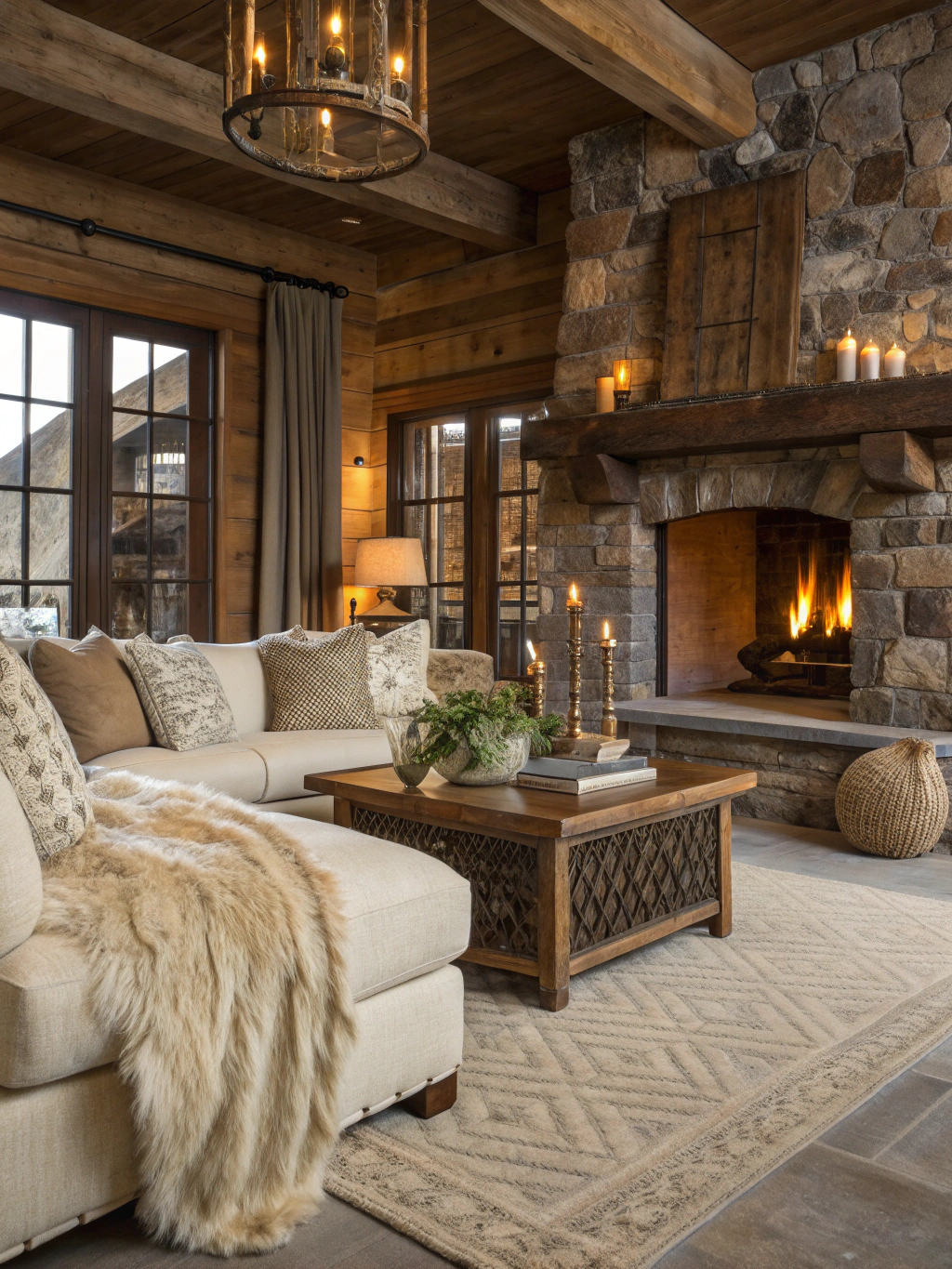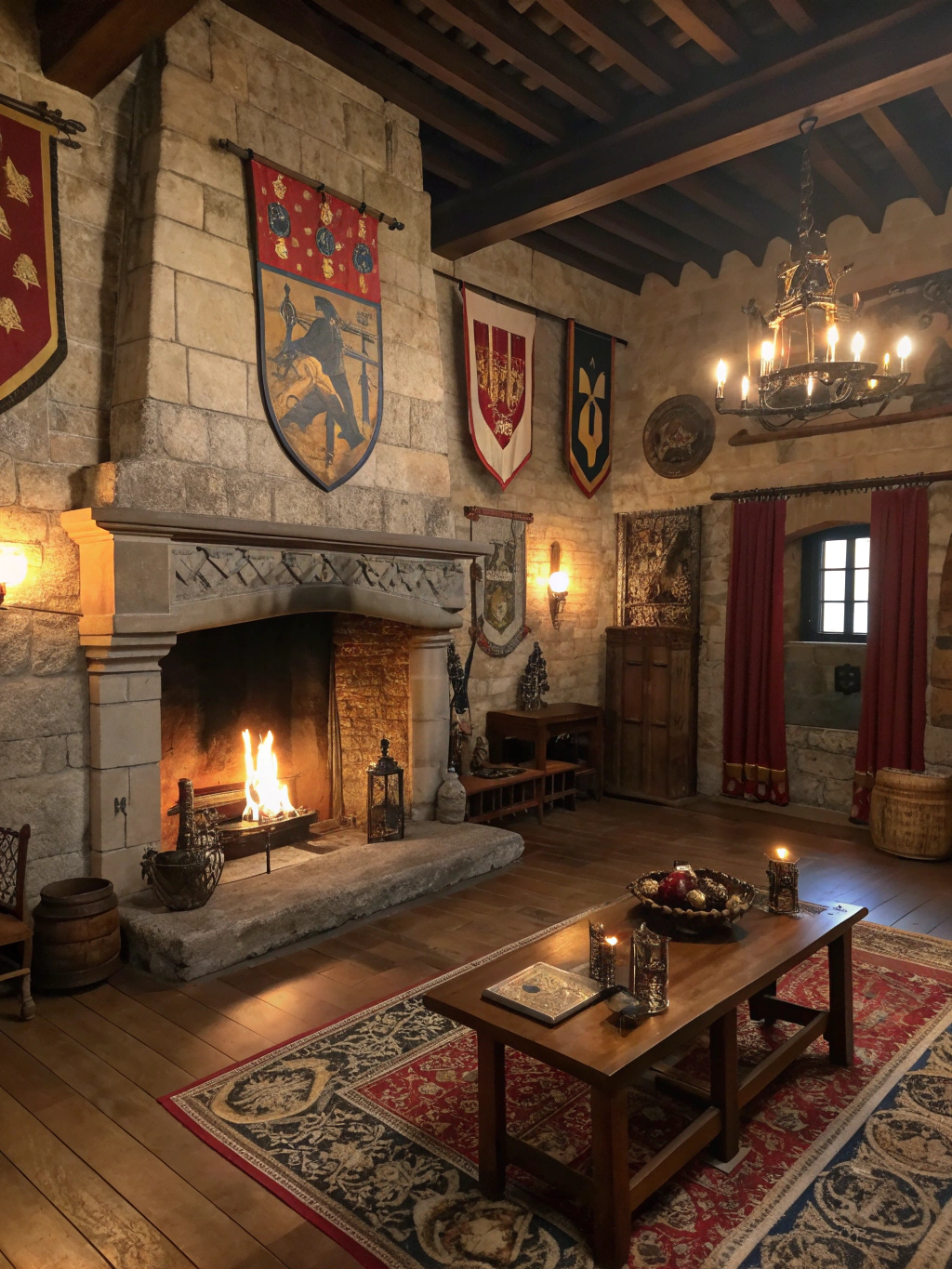Medieval Living Room Design with Modern Comfort
Okay, so picture this: I'm sitting in my living room last Tuesday, wrapped in what can only be described as an absurdly oversized blanket (you know the type – the one that makes you look like a medieval peasant who just robbed a castle), and I'm watching Game of Thrones for the millionth time. My husband walks in, sees me surrounded by candles I impulse-bought from Target, and goes, "Are we living in the Dark Ages now?"
And honestly? That got me thinking. What if we were?
Not literally, of course – I'm too attached to my WiFi and indoor plumbing, thank you very much. But there's something undeniably cozy about medieval living room design that just… works. It's that perfect blend of "I could definitely defend this space from invaders" and "but also, let's binge Netflix here." The heavy wooden beams, the rich tapestries, that whole castle-meets-cottage vibe that makes you want to light every candle you own and pretend you're about to host a feast for weary travelers.
The thing is, creating that medieval atmosphere doesn't mean you have to sacrifice comfort or, heaven forbid, electricity. Trust me, I've spent the last three years slowly transforming our cookie-cutter suburban living room into what my sister lovingly calls "Renaissance Faire Chic," and I've learned a thing or two along the way.
Start with Stone (Or at Least Pretend To)
Here's where I made my first mistake – and subsequently discovered my first brilliant solution. Real stone walls? Yeah, not happening in a rental. But those peel-and-stick stone wallpaper panels from Wayfair? Chef's kiss.
I started with just one accent wall behind our TV (because let's be real, we're not giving up the 65-inch screen for authenticity). The faux stone has this gorgeous gray texture that catches the afternoon light streaming through our west-facing windows, creating shadows that shift throughout the day like a sundial. Sometimes I catch myself just staring at it while my coffee gets cold.
The trick is to not go overboard. One stone wall says "medieval charm." Four stone walls says "we're LARPing 24/7 now."
The Power of Dark Wood and Heavy Furniture
Remember when everyone was all about that minimalist, Scandinavian look? Yeah, me too. But medieval living room design laughs in the face of your delicate mid-century modern coffee table.
We found this massive oak entertainment center at an estate sale – the kind that looks like it could double as a barricade if necessary. It's got these iron hinges that squeak just enough to be atmospheric without being annoying, and shelves deep enough to hide my embarrassing collection of fantasy novels behind more respectable-looking leather-bound classics.
Pro tip: Craigslist and Facebook Marketplace are goldmines for this stuff. Search for "rustic," "farmhouse," or "Gothic" furniture. Last month, I scored two throne-like chairs for $50 because someone's ex left them behind and they "gave her the creeps." Her loss, my medieval gain.
Layer Your Lighting Like a Medieval Master
This is where modern comfort really shines (pun absolutely intended). Medieval castles had terrible lighting – we're talking torches, candles, and whatever sunlight managed to squeeze through those tiny windows. But we can do better while keeping the vibe.
I've got:
- Wrought iron chandeliers with LED Edison bulbs (atmosphere without the fire hazard)
- Battery-operated pillar candles clustered on every flat surface
- Hidden LED strips behind the ceiling beams for when I actually need to see
- Salt lamps that give off this warm, amber glow that makes everyone look like they're in a Rembrandt painting
The key is layers. During the day, natural light pools across our burgundy velvet couch (found it on clearance at World Market, and yes, it shows every single cat hair). By evening, we've got this graduated lighting situation that would make any medieval hall proud.

Textiles: Where Comfort Meets Castle
If there's one thing medieval folks understood, it was the power of textiles. Tapestries weren't just decoration – they were insulation, baby.
My living room currently features:
- A reproduction medieval tapestry from Museum Replicas (bit pricey, but so worth it)
- Throw pillows in jewel tones – emerald, ruby, sapphire
- Faux fur throws draped over literally everything
- A Persian-style rug that's probably not historically accurate but who's checking?
The velvet curtains were a game-changer. Heavy enough to block out light for impromptu afternoon naps, but luxurious enough to make you feel like nobility. Got them during Pottery Barn's semi-annual sale, and I may have happy-danced in the store.
The Modern Knight's Entertainment Center
Here's where we get real about medieval living room design in the 21st century. That TV isn't going anywhere, and neither is the PlayStation. But that doesn't mean they have to ruin the aesthetic.
We built a custom frame around our TV using reclaimed barn wood and iron corner brackets. When it's off, it almost looks like a massive dark mirror or piece of art. Almost. The gaming consoles hide in woven baskets that look period-appropriate enough if you squint.
And yes, we have a sound bar. It's tucked behind a piece of decorative iron scrollwork I found at Hobby Lobby. Medieval problem-solving at its finest.
Create Cozy Conversation Nooks
Medieval great halls weren't just one big open space – they had alcoves, window seats, little spots where conspiracies were plotted and romances bloomed. Or, you know, where you can scroll Instagram in peace.
We turned our bay window into a reading nook with floor cushions covered in tapestry-print fabric (thank you, Joann's remnant bin) and a small side table that's literally just a tree stump we sealed and added hairpin legs to. There's usually a half-drunk mug of tea balanced precariously on top, alongside a teetering stack of books I swear I'll get to someday.
Add Authentic(ish) Details
The devil's in the details, and so is the medieval magic:
- Iron wall sconces from Restoration Hardware (got them on super sale)
- A wooden treasure chest that doubles as a coffee table and storage for blankets
- Pewter goblets from the Renaissance festival that we absolutely use for wine
- A coat of arms I designed on Etsy (it has our cats on it, don't judge)
- Dried herbs hanging from the ceiling beams (they smell amazing and hide the spot where we patched the drywall)
My personal favorite? The sword letter opener on the mantle. Completely unnecessary, utterly delightful.
Mix Modern Comfort with Medieval Charm
Let's talk about the elephant in the room – or rather, the recliner in the castle. Some modern conveniences are non-negotiable. The trick is integration.
Our electric fireplace? Surrounded by stacked stone veneer. The ceiling fan? Replaced with one that has wrought iron-looking blades. The smart home devices? Hidden inside decorative boxes or behind medieval-style screens.
And yes, we have a humidifier. Castles were notoriously damp, but controlled humidity is better than actual dampness, trust me.
Don't Forget the Finishing Touches
This is where you can really have fun:
- Vintage books stacked horizontally (vertical screams "library," horizontal whispers "casual scholar")
- Brass candlesticks of varying heights clustered together
- A vintage world map (got mine from a closing teacher supply store)
- Plants in earthenware pots (pothos is basically indestructible, perfect for dimly lit castle vibes)
Sometimes I add seasonal touches too. Pine boughs in winter, wildflowers in mason jars come spring. Medieval folks were connected to the seasons, after all. Though I doubt they had pumpkin spice candles.
Creating Your Own Medieval Living Room Design
Here's the thing about medieval living room design – it's not about historical accuracy. It's about creating a space that feels like a refuge from the modern world while still being, you know, livable.
Start small. Maybe it's just adding some iron accents or swapping out your throw pillows for something in rich, jewel tones. Rome wasn't built in a day, and neither was my pseudo-castle living room. (It took three years and way too many trips to HomeGoods.)
The beauty of this style is that it's forgiving. That coffee ring on your wooden coffee table? Character. The cat scratches on your leather ottoman? Battle scars. The slightly crooked tapestry? Adds to the hand-hewn charm.
Living the Dream (Castle Optional)
So here I sit, three years into this medieval living room design journey, sipping coffee from a mug that looks vaguely like a chalice if you don't look too closely. The morning sun is hitting the faux stone wall just right, the fake candles are flickering convincingly, and my cat is perched on his throne-chair like the tiny tyrant he is.
Is it perfect? Nope. Does it occasionally look like a Renaissance festival threw up in here? Maybe. But when friends come over, they immediately sink into our oversized furniture with a contented sigh, grab one of the many (many) throw blankets, and say something like, "Your place always feels so cozy."
And really, isn't that what medieval living room design is all about? Creating a space that makes you want to gather 'round with your favorite people, share stories, maybe plot to overthrow a kingdom or two (in D&D, obviously), and feel like you're somewhere special – even if that somewhere is really just your suburban living room with surprisingly good WiFi hidden behind a tapestry.
Now if you'll excuse me, I need to go light some more battery-operated candles and pretend I'm not procrastinating doing the dishes. After all, even castle dwellers had to deal with dirty goblets… eventually.
What's your take on medieval living room design? Have you tried incorporating any castle-worthy elements into your space? Drop a comment below – I'd love to hear about your adventures in home décor time travel!





